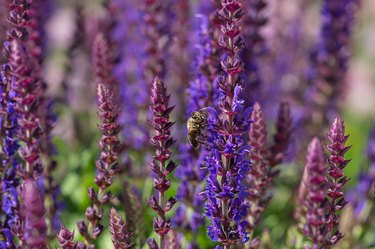
Sage (Salvia officinalis, USDA plant hardiness zones 4 through 11) is as well-known for its historical use in medicine and rituals as its culinary use. As low-maintenance as it can be, like all plants, sage can still suffer and die if not properly cared for. If you catch it quickly enough, you may be able to fix a sage plant that's dying.
Why Is My Sage Plant Dying?
Video of the Day
When used in cooking, sage adds a warm, savory flavor; it's the key to traditional Thanksgiving stuffing, for example. Sage is also used as an essential oil and an antiseptic, and has been used in holistic healing practices to improve brain function, oral health and nervous conditions.
Video of the Day
It's native to the Mediterranean region, but is a fairly hardy plant and is usually easy to grow in a variety of climates, especially if potted. While many people grow it for use as an herb, others enjoy the way it looks in a garden; sage has silvery-green leaves and can produce tall flowers in a number of shades.
Sage is mostly sensitive to conditions unlike its native environment. Sage is naturally drought-resistant and expects well-draining soil. If you've overwatered your sage, or if it's in a pot or container that doesn't have good drainage, you'll see the leaves start to wilt and droop. Too much rainfall will produce the same effect for an outside plant. If not corrected, this can eventually cause root rot.
Troubleshooting Sage Plants
If you don't think it's water or drainage causing issues with your sage plant, it could be a fungus. If your leaves are wilting, turning yellow and falling off, you may have Verticillium wilt, caused by fungal disease. This fungus can spread to other nearby plants, so isolate your sage immediately if you think this is the cause. You can treat the soil with a fungicide, but in most cases, you're going to lose the plant.
Unbalanced soil conditions can cause poor growth in sage, and this includes over-fertilization as well as the more obvious under-fertilization. Again, sage thrives in sandy, loamy soils that are often thin in nutrients. You can shock your sage by over-fertilizing it, as an abundance of nitrogen will overload the plant, adversely affecting its foliage. Look for soft leaves that grow droopy or wilted almost immediately.
If none of these seem accurate, consider that your sage may be in a pot that's too small. Smaller pots heat up more quickly, making water evaporate; even though sage likes drier conditions, the plant will still need to have water available. If the sage has taken up most of the pot, it isn't going to be able to grow and will eventually fail.
Reviving a Dying Sage Plant
If the culprit turns out to be watering, that can be easy to fix. Move wilted plants into a pot, and choose one with drainage holes in the base so that conditions don't get overly wet. Sage grows best when watered every one to two weeks, although younger sage will need to be watered more frequently. When planting, be sure to use a soil mix that contains some sand, which will help the drainage. Find a balanced schedule for watering based on the conditions.
For outdoor plants in a garden, it's harder to control watering (check the rainfall in your area), so your best bet will be to modify the soil where your sage is planted to contain more sand, and make sure it's positioned in a place to get full sun. Be sure to plant your sage 24 to 36 inches apart.
Sage normally grows better in a pot or container, mainly because the soil composition can be tailored specifically to match its needs. Sage can be fertilized with a very light hand in the spring. Otherwise, the plant will start to overproduce leaves of poor quality.